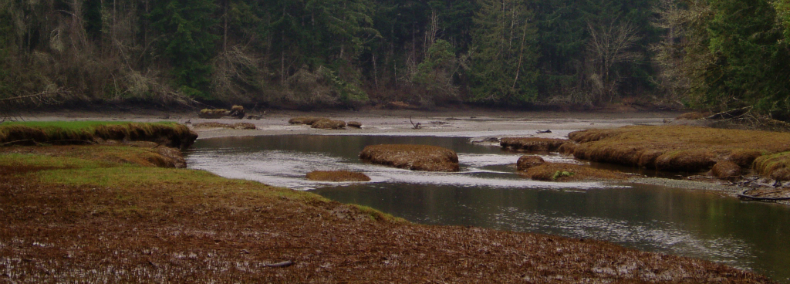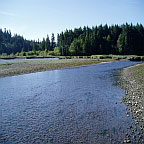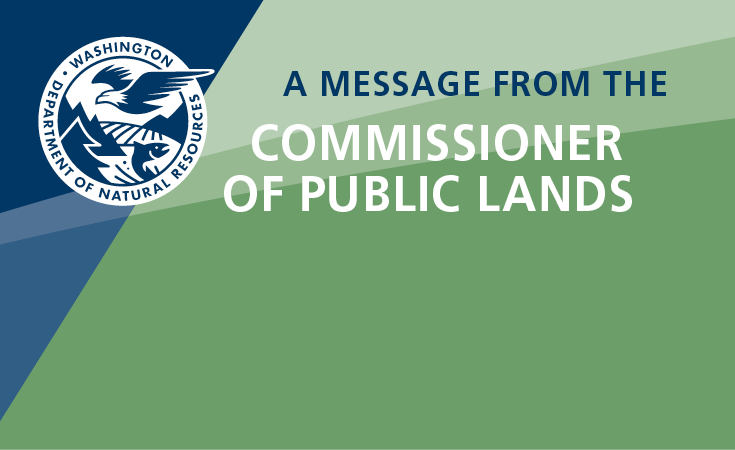Kennedy Creek Natural Area

This combined natural area preserve (NAP) and natural resources conservation area (NRCA) protects 1,121 acres, including most of the creek and estuary on the Puget Sound. Kennedy Creek Natural Area Preserve (NAP) includes the tidal reaches of Kennedy Creek and Schneider Creek, as well as adjacent salt marsh, tide flats, uplands and riparian forests. The salt marsh protected at the preserve is among the highest quality in the Puget Trough Ecoregion.
Natural Features: The Washington Natural Heritage Program recommended Kennedy Creek NAP to protect three intertidal salt marsh ecosystems characterized by gradients in elevation, salinity, and soil texture:
- The moderate-salinity, high marsh ecosystem supports the mud rush and tufted hairgrass–Pacific silverweed plant communities.
- The silty, moderate-salinity, low marsh ecosystem supports the pickleweed–saltgrass–seaside arrowgrass–(fleshy jaumea) plant community.
- The silty, low-salinity, low marsh ecosystem supports the Lyngby’s sedge plant community. This ecosystem is within the preserve design, but is not yet owned by the state or managed by DNR.
Without active conservation management, these ecosystems are vulnerable to decline from invasive weeds or other contaminants and disturbance. Kennedy Creek NAP plays an important role in conserving high-quality examples of these ecosystems, which are becoming endangered throughout their range.
The mudflats protected at Kennedy Creek NAP provide critical feeding areas for more than 140 species of birds including large concentrations of shorebirds and predatory species like peregrine falcons and red-tailed hawks. In a single day, 10,000 migratory shorebirds have been counted in the estuary. Each winter, an estimated 2,000 to 5,000 dunlin spend the cold months at Kennedy Creek. This is the largest concentration in central and southern Puget Sound. The site also supports one of the largest concentrations of wintering and migrating black-bellied plovers in the region.
Kennedy Creek provides habitat for coastal cutthroat trout, steelhead, and Coho salmon. The site is known for its robust run of fall chum. Between October and December, on average 21,000 chum return to spawn in 2.5 miles of freshwater at Kennedy Creek. After spawning, the salmon carcasses provide important marine derived nutrients to the riparian and estuarine ecosystem, sustaining the health of the flora and fauna. The nutrients from the thousands of carcasses supplement the diets of newly emerged chum fry along with more than 60 different species of wildlife, including the northern river otter, red-tailed hawk and bobcat. Invertebrates living in the intertidal muck consume the carcasses that wash down the creek, after which they are, in turn, consumed by shorebirds.
Features protected: High- and low-marsh wetland ecosystems, habitat for shorebirds and waterfowl, resident coastal cutthroat, winter steelhead, Coho and chum salmon, bald eagles, marbled murrelets, peregrine falcons and purple martins.
Ecoregion: Puget Trough (Mason and Thurston Counties)
Ecoregion: Puget Trough (Mason and Thurston Counties)
Science, Research and Monitoring
Kennedy Creek NAP has an ongoing research and monitoring program. As part of the larger watershed, the NAP is an important research site for scientists studying salmonid ecology. In addition, a number of monitoring and research efforts have been focused on the shorebird population, including studies of abundance, migration, behavior and diet. A recent study by researchers from Simon Fraser University in British Columbia on the metabolism of migratory shorebirds provided information about the relative importance of different estuaries for shorebirds and factors contributing to the quality of stopover sites.
If you are interested in pursuing a research project, please contact David Wilderman, Natural Areas Program statewide ecologist, at david.wilderman@dnr.wa.gov.
Examples of past research and monitoring projects
- Salt marsh vegetation monitoring — Natural Areas Program staff conduct periodic assessments of the salt marsh communities on the site to track changes in species composition and abundance.
- The abundance and migration of shorebirds at two Puget Sound estuaries. Buchanan, J.B. 1988. Western Birds 19:69-78.
- Dunlin weight changes in relation to food habits and available prey. Joseph B. Buchanan, Leonard A. Brennan, Charles T. Schick, Michael A. Finger, Tod M. Johnson, and Steven G. Herman. 1985. Journal of Field Ornithology 56:265-272.
- Observations of chum salmon consumption by wildlife and changes in water chemistry at Kennedy Creek during 1997-2000. Joseph Jauquet, Ned Pittman, Jeffrey A. Heinis, Steven Thompson, Nui Tatyama, and Jeff Cederholm. 2003. American Fisheries Society Symposium 34:71-88.
Environmental Education and Public Access
Kennedy Creek NAP offers an excellent outdoor classroom and it is convenient to many school communities in the southern Puget Sound area. An interpretive site that overlooks the preserve and Oyster Bay was constructed in 2008. The site includes signs illustrating the interconnectedness between salt marsh, shorebirds and salmon. Also, the preserve has become an important linkage in the story of the chum salmon for students and community members visiting the Kennedy Creek Salmon Trail, which is located two miles upstream and highlights the value of stream habitat for salmon. Like the Salmon Trail, Kennedy Creek NAP has a volunteer steward program to maintain the interpretive area.
A Washington State Discover Pass is required for parking at this site. This funding helps DNR manage these important natural areas across the state.
For more information about educational visits to Kennedy Creek NAP, contact the DNR South Puget Sound Region natural areas manager, listed here.
Volunteer and Stewardship Opportunities
If you are interested in volunteer and stewardship opportunities in the Kennedy Creek NAP, please contact the DNR South Puget Sound Region natural areas manager.
Directions to Kennedy Creek NAP
From Interstate 5 in Olympia, take Exit 104 toward Port Angeles/Aberdeen (westbound WA-8/ US-101). Continue about 4.5 miles and exit to the right to remain on US-101 northbound (toward Port Angeles). Travel about 11 miles and then, after crossing the highway bridge at Kennedy Creek, exit to the right on Old Olympic Highway. Continue past the small parking area visible from the highway, travelling another 0.2 mile and the Kennedy Creek NAP parking area is on the right. A short path leads to an overlook with interpretive signs. The parking lot accommodates about 5 cars or vans.


